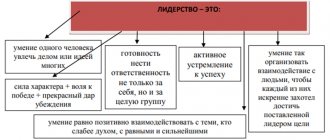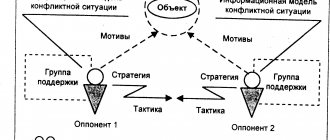Author Tatyana on 08/17/2014. Published by Cognitive Psychology Last updated: 08/17/2014
Self-awareness is one of the first components of self-concept. Although self-awareness is central to all of us, we do not yet understand it well enough today. Researchers have demonstrated that a person's self-awareness begins to emerge within a year of birth and develops within another six months.
Glossary of terms and their relationships
The term “self-knowledge” itself has ancient roots, the beginning of which leads us along the road to deep antiquity. This saying was first attributed to the Greek philosopher Plato in his famous treatise Protagoras.
Self-knowledge is a personal study of physical and psychological characteristics, analysis of one’s own feelings and emotions. The process of self-knowledge of a person begins from infancy, when he begins to feel his body and react to the environment, and ends only at the end of a person’s life path - his physical death.
Of course, the process of self-development would be absolutely impossible without another manifestation of an important component of human nature - consciousness. These terms are closely related; it would even be correct to note that the first is a logical continuation of the second. Consciousness is a manifestation of the highest form of human development. With his active assistance, everyone is able to evaluate their own, as well as the activities of individual representatives of society, their model of communication and behavior.
The next term that we will need to study the basics of personal development is “self-esteem” - one of the components of self-awareness, in fact, an adequate assessment of oneself without any warnings. The influence of self-esteem on self-knowledge is an important factor. It is necessary to take into account that without a sober assessment of oneself, which excludes unnecessary exaggeration and belittlement, personal development is simply impossible. It comes in several varieties:
- The current one is an assessment of one’s own actions, including misconduct. With all this, there is no emotional coloring; in this case, cold logic plays the dominant role;
- Adequate - critical, but at the same time correct identification of one’s own shortcomings and the search for ways to eradicate them;
- Inadequate is an absolutely biased description of oneself. Assigning consciously negative qualities to oneself, while making no attempt to correct anything;
- Personal self-esteem – determining the level of self-satisfaction in all its manifestations.
Structure and forms of self-awareness
Social nature of consciousness
2. Structure and forms of self-awareness
Self-awareness is a dynamic, historically developing formation that appears at different levels and in different forms.
Its first form, which is sometimes called well-being, is an elementary awareness of one’s body and its fit into the world of surrounding things and people. It turns out that the simple perception of objects as existing outside a given person and independently of his consciousness already presupposes certain forms of self-reference, i.e. some kind of self-awareness. In order to see this or that object as something existing objectively, a certain mechanism must be “built in” into the process of perception itself, taking into account the place of the human body among other bodies - both natural and social - and the changes that occur with the human body in contrast to what happens in the outside world.
The next, higher level of self-awareness is associated with awareness of oneself as belonging to one or another human community, one or another social group.
The highest level of development of this process is the emergence of the consciousness of “I” as a completely special formation, similar to the “I” of other people and at the same time unique and inimitable in some way, capable of performing free actions and being responsible for them, which necessarily implies the ability to control your actions and evaluate them. Here it is necessary to highlight such an aspect as consciousness. Consciousness is characterized primarily by the extent to which a person is able to realize the social consequences of his activities. The greater the place in the motives of activity occupied by the understanding of social duty, the higher the level of consciousness. A person is considered conscious if he is able to correctly understand reality and, in accordance with this, control his actions.
Consciousness is an integral property of a mentally healthy human personality. The ability to understand the consequences of an action is sharply reduced and even completely absent in children, as well as in the mentally ill. Consciousness is a moral and psychological characteristic of a person’s actions, which is based on consciousness and assessment of oneself, one’s capabilities, intentions and goals.
However, self-awareness is not only the various forms and levels of self-knowledge. It is also always about self-esteem and self-control. Self-awareness involves comparing oneself with a certain ideal of “I” accepted by a given person, making some self-assessment - as a result, the emergence of a feeling of satisfaction or dissatisfaction with oneself. The “mirror” in which a person sees himself and with the help of which he begins to relate to himself as a person, that is, develops forms of self-awareness, is the society of other people. Self-awareness is born not as a result of the internal needs of an isolated consciousness, but in the process of collective practical activity and interpersonal relationships.
3. Subjectivity and reflexivity of self-awareness
Self-awareness exists not only in different forms and at different levels, but also in varying degrees of manifestation and development. When a person perceives a group of objects, then this must be associated with awareness of the “body diagram”, the place that his body occupies in the system of other objects and their spatial and temporal characteristics, awareness of the difference between the consciousness of this person and the objects he perceives, etc. . However, all these facts of consciousness are in this case not in its “focus”, but, as it were, on its “periphery”. Human consciousness is directly aimed at external objects. A person's body, his consciousness, his cognitive process are not directly included in the circle of objects of his conscious experience. Self-awareness in this case is expressed in an “implicit” way.
Explicit forms of self-consciousness, when certain phenomena of consciousness become the subject of special analytical activity of the subject, are called reflection. Reflection is a person’s reflection on himself, when he peers into the hidden depths of his inner spiritual life. Without reflection, a person cannot realize what is happening in his soul, in his inner spiritual world. Levels of reflection can be very diverse - from elementary self-awareness to deep reflection on the meaning of one’s existence, its moral content. It is important to note that reflection is always not just an awareness of what is in a person, but always at the same time a remaking of the person himself, an attempt to go beyond the boundaries of the level of personal development that has been achieved. Reflection itself on states of consciousness, the characteristics of a particular personality, always arises in the context of a conscious or unconscious task of restructuring the system of consciousness and personality. When a person recognizes himself as an “I” with such and such characteristics, he transforms some previously fluid and seemingly “dispersed” moments of his mental life into a stable object. A person reflectively analyzes himself in the light of one or another personality ideal, which expresses his type of attitude towards other people. When a person analyzes himself, tries to give an account of his characteristics, reflects on his attitude to life, strives to look into the recesses of his own consciousness, he thereby wants to, as it were, “substantiate” himself, to better root the system of his own life guidelines, from something in himself to give up forever, to strengthen oneself in something even more. In the process and result of reflection, a change and development of individual consciousness occurs.
One should not, however, think that the image of oneself that a person creates in various forms of self-consciousness is always adequate to its subject - a real person and his consciousness. There may be a gap between them, the possibility of which is especially great precisely at the stage of developed explicit self-awareness in the form of reflection. However, this gap may also exist in elementary forms of self-awareness, self-construction, and self-determination of the individual.
It is important to emphasize that self-awareness not only arises in the process of joint activity and communication with other people and is genetically connected with the attitude towards oneself from the “point of view of another”, but also that it is constantly checked, adjusted, corrected and developed during the inclusion of a person in the system of interhuman relationships.
IV. Conclusion
In conclusion, let us summarize the work done.
Consciousness is the highest form of reflection of the world, characteristic only of man. It is associated with articulate speech, logical generalizations, and abstract concepts. The “core” of consciousness is knowledge. Having a multicomponent structure, consciousness is, nevertheless, a single whole.
So, consciousness acts as a key, initial philosophical concept for the analysis of all forms of manifestation of a person’s spiritual and mental life in their unity and integrity, as well as ways of controlling and regulating his relationships with reality, managing these relationships.
Self-awareness is part of consciousness, or rather its special form. Self-awareness presupposes the isolation and differentiation by a person of himself, his Self from the surrounding world. Self-awareness is a person’s awareness of his actions, feelings, thoughts, motives of behavior, interests, his position in society. It appears both in the form of individual and in the form of social self-awareness. Self-awareness is reflexive, with its help a person evaluates himself, his place in life and society, and his actions.
Self-awareness did not arise as a spiritual mirror for man’s idle narcissism. It appeared in response to the call of social conditions of life, which from the very beginning required from each person the ability to evaluate his actions, words and thoughts from the position of certain social norms.
The phenomenon of self-awareness, which seems to be something very simple and obvious, in reality turns out to be very complex, diverse, in a very difficult relationship with its carrier, developing and changing in the process of including a person in the system of collective practical activity and inter-human relations.
Despite the enormous efforts expended by philosophy and other sciences, the problem of human consciousness (individual and social) is far from being solved. There are many unknowns hidden in the mechanisms, functions, states, structure and properties of consciousness, its relationship with the activities of the individual, the ways of its formation and development, and connections with existence. It is important to emphasize that the question of the relationship between consciousness and being is not reduced to the question of primacy and secondaryness, although it proceeds from this. The study of the relationship between consciousness and being includes the study of all diverse and historically changing types and forms, i.e. in some ways this is the “eternal question”. “Eternal” in the sense that the development of forms and human life, the progress of science and culture constantly complicate and change the specific forms of the relationship between consciousness and being and pose many problems for philosophical thought.
Bibliography:
1. Tugarinov V.P. Philosophy of consciousness. Moscow 1971
2. Spirkin A.G. Philosophy. Moscow 1998
3. Georgiev F.I. Consciousness, its origin and essence. Moscow 1967
4. Introduction to philosophy. Textbook for universities in 2 parts. Part 2.
Politizdat 1989
6. Alekseev P.V., Panin A.V. Philosophy. Moscow 1999
Social nature of consciousness
Information about the work “Consciousness and Self-Awareness”
Section: Philosophy Number of characters with spaces: 44763 Number of tables: 0 Number of images: 0
Similar works
Consciousness and psyche. Levels of consciousness. Consciousness and self-awareness. The phenomenon of the human “I”
42983
0
0
... for this purpose, preference should be given to complex research methods to determine the adequate specificity of consciousness. It is hoped that this will lead to a solution to the problem of consciousness. Consciousness and self-awareness. Self-awareness is defined as “a person’s awareness and assessment of his knowledge, moral character and interests, ideals and motives of behavior, a holistic assessment of himself as a feeling and...
Consciousness and self-awareness of the individual
24684
0
0
..., phenomena, people. These forms and types of relationships are synthesized in the structures of consciousness, and they determine both the organization of behavior and the deep processes of self-esteem and self-awareness. Really existing in a single stream of consciousness, an image and a thought can, colored by emotions, become an experience. Consciousness develops in humans only through social contacts. In phylogenesis, human consciousness developed...
Psychological features of moral self-awareness in adolescence
155236
7
0
... the chosen option or combination when working with adolescents ensures the most effective implementation of the possibilities of socio-psychological training. CONCLUSION The study of the characteristics of moral self-awareness in adolescence presented in this thesis is very relevant, as it reflects the need for a psychological analysis of the situation associated with decisive...
Linguistic consciousness and features of its manifestation among representatives of the Russian and Kazakh ethnic groups (sociolinguistic and psycholinguistic aspects)
384767
4
0
... the material shows the results of contacts between different ethnic groups living in Kazakhstan. Very important is the sociolinguistic material concerning the interaction of the Russian and Kazakh ethnic groups and the contact of their languages. It should also be emphasized the work of K.M. Abisheva, which describes in detail the linguistic contacts of the named ethnic groups over many centuries. If we consider the contacts of the Russian and...
Stages of development of self-knowledge
The process of human self-knowledge is a multi-level algorithm, all links of which are interconnected. It is impossible to move on to the next stage without completely completing the previous one. There are only four levels, or let’s call them stages, of self-knowledge:
- Sensual – the most primitive level. We are able to feel the necessary, disturbing processes in our body, to feel the simplest mental influences from the outside. At this level, the features of a person’s self-knowledge are practically invisible. A person is indistinguishable from other representatives of his own kind;
- Personal - at this stage a person becomes more and more selfish. He is fixated on his inner experiences, awareness of himself as an individual, who has both negative and positive character traits;
- Analytical with an intellectual bias - awareness of one's own thought processes, using tools such as introspection and observation. The subject is more and more interested in direct contemplation from a distance rather than active participation. This moment can be compared to the chrysalis of a butterfly, which is almost ready to reveal itself to the world in all its inherent beauty;
- Active – the merging of all three previous levels of self-knowledge. With the achievement of practical perfection in the use of self-criticism and self-control. There is also an absolute loss of fear of any form of self-expression.
Errors in development
Every major age-related crisis is needed for the psyche to undergo changes and improve its functioning. If something goes wrong at this point, problems will arise.
Against this background, abnormal behavior develops
Violations may manifest themselves in the fact that the individual begins to avoid any contact with other people. Any social life scares him; it seems to him that it is better to do without it.
He develops a fear of change and a refusal to grow up. He behaves childishly, inadequately and frivolously. Self-awareness occupies an important place in psychology precisely because through it the individual analyzes his state and behavior.
With abnormal development, a person has a desire to choose the wrong role models. Among them there will not necessarily be famous people. In some situations, an unfavorable Self-Concept is formed.
Self-concept manifests itself in uncertainty and low self-esteem
In such a scenario, a person will have a tendency to negative emotions, asociality, and aggressiveness. The quality of life will be low, and gradual degradation of personality will occur. The individual inadequately evaluates himself and his actions and is not prone to self-criticism.
Self-awareness is needed in order to clearly understand your place in life, analyze actions and interact with other people. Some people call intuition the ability to predict the future, but in reality it is just good self-awareness. It is this that enables the individual to perceive himself as a creature separate from the world.
Many issues are considered from a philosophical perspective. For example, how deeply a person can understand the existence of himself, and what place and role is assigned to him. At the same time, the concept of self-awareness is considered in psychology as a manifestation of the functioning of the brain.
Understanding the basics of how the psyche works allows people to improve the quality of their lives. Therefore, it is useful to know what self-awareness is, its definition in different sciences, and how it manifests itself.
Features of personality self-knowledge: main functions
This whole multifaceted process is very dynamic - it is constantly in a state of active development. We are constantly learning something new that helps us in the future. This serves as additional tools in self-knowledge of our personality. Ultimately, self-knowledge as a component of self-awareness is just an end product of consumption on which everyone is dependent.
When characterizing this nonsense, one cannot fail to mention its most important functions, which are expressed in the self-defense of a person’s inner peace. This is nothing more than resistance to possible insults, negative factors that can cause great damage to a person’s psychological balance, as well as inner peace. In particular, you should remember about the formation of your individual and unique personality, the personal “I” of which did not exist before.
Under personalized consciousness, i.e. “I” understand distinctive character traits, charisma, and pronounced behavioral patterns.
Not the last factor also affects a person’s self-esteem. Self-knowledge as a component of self-awareness is distinguished by the possibility of self-identification. the presence of children's hidden fears and complexes that will interfere with the development process in any direction throughout life.
Types of self-awareness
Psychologists often distinguish different types of self-awareness: Social self-awareness . This type of self-awareness occurs when people become aware of how they appear to others. Social awareness often occurs in situations where people are the center of attention, such as when giving a speech or chatting with a group of friends. This type of self-awareness often causes people to adhere to social norms. When we perceive that we are being watched and judged, we often try to behave in ways that make us appear socially acceptable and desirable to others. Social consciousness can also lead to anxiety, in which people become uneasy and worried about how others perceive them. Private self-awareness . This type occurs when people become aware of certain aspects of themselves. For example, when you see your face in a mirror and are aware of it, this can be considered a type of private self-awareness. Unpleasant feeling in your stomach when you realize you forgot to study for an important test; the fluttering of your heart when you see someone you find attractive are also excellent examples of this type of self-awareness.
Self-knowledge as a component of self-awareness in the teachings of Carl Jung
The peak of desire in the study of personal growth, as well as related aspects, fell in the 20th century, when such stars as Sigmund Freud and Carl Jung firmly established themselves in the firmament of psychology. It is the latter, or rather, his famous theory, that will be discussed now.
According to Jung's theory, self-knowledge as a component of self-awareness is formed at an unconscious level, including in its structure a person's (unconscious) desire for the best, practically perfection. Each of us is motivated by personal beliefs, finding a logical explanation for which is impossible. We are initially “programmed” for such a desire. The scientist argued that the inner “I” of a person, his entire individuality, is subject to a certain cyclicity and structure. He derived a model of this structure based on Freud’s work - “Ego”, “Personal Unconscious” and “Personal Conscious”.
Freudianism in Jung's theory
The ego is the core of all consciousness . Includes the presence of such internal resources as: thoughts, feelings, desires, emotions and memories. With their help, the individual feels whole and also perceives himself as a full-fledged unit of society. All these sensations, especially knowing yourself at this level, provide a chance to study the results of your conscious activity ;
Personal conscious – analysis of current problems, possible experiences that need to be overcome here and now. Consciously aimed at the possibility of solving problems, using various tactics of action, thus continuing learning. According to Jung's theory, the personal conscious is the tip of the iceberg itself, which does not bring significant discomfort, but rather the irritation of an unresolved problem. The third component is another matter.
Personal unconscious - all previously experienced conflicts, emotional upheavals, any other shocks that have been forgotten after some time, but are deeply rooted in our subconscious. This statement is similar to Freud's, but Jung's theory has a deeper meaning. It says that hidden complexes, the presence of which we may not even suspect, can cause us significant trouble. Affect the behavior of the individual as a whole.
For example, a person who has strived for power all his conscious and unconscious life is absolutely incapable of working in a team and obeying orders. He forgets that in order to achieve his dream of power, he must go through all stages of development, starting from the very bottom. Of course, only by getting into trouble will he be able to realize the wrongness of his actions and try to correct them.
Development
Personality orientation - what is it in psychology, its types
Personal self-awareness in psychology is not something that a person has at birth. Normally, a child gradually develops ideas about himself. This is especially evident in the level of self-esteem.
Important! Experts do not have a consensus on how development occurs.
V. Bekhterev believed that self-awareness precedes consciousness. L. Vygotsky believed that this is the stage before the appearance of independence and speech. P. Chamata expressed a different point of view: a person’s self-awareness is his degree of mastery of the body.
Experts agree on one thing: the process of cognition appears from the moment of birth
The scientific literature discusses its gradual formation, which occurs as the baby grows up. At first, the child is dependent on the mother, but by the age of three he understands his independence and begins to defend it.
Development in ontogenesis
The first stage lasts up to a year. During this period, the child does not distinguish himself from the world around him; he is driven by instincts. The first games give him the opportunity to realize himself.
The second stage lasts up to three years. In it, the child begins to actively explore the world, take actions and study the reactions of other people. He has the prerequisites for distinguishing his own “I”.
The third stage lasts until the age of seven. During this period, the baby begins to talk about himself in the first person; he strives for knowledge and mastering skills. The child asserts independence and learns to communicate with others.
The fourth stage lasts up to 12 years. This time is ideal for educational activities, and it is not accompanied by any special crises. The fifth stage lasts until the age of 14. It shows a child trying to understand himself and contrast himself with adults.
The sixth stage is the most important, it lasts until the age of 18. On it, a person searches for himself, collects brief information about his sides, tries to understand who to become. This stage is necessary for growing up.
The concept of archetypes in Jung's theory
The concept of archetypes, which was developed within the framework of Jung's theory, is also of genuine interest. These archetypes are a set of images that prove in practice that self-knowledge as a component of self-awareness mainly operates at the subconscious level, rather than during analysis as a whole. We try on the model of a specific archetype, which plays a leading role in our subconscious. The leading images (archetypes) in his mind were:
- The shadow is a totem of the dark essence of humanity: all its suppressed emotions (fear, aggression), which are essentially an animal essence. It lacks any moral and ethical standards inherent in the individual. This imprint carries all the dreams that are condemned by society, but no less desirable. But despite this, the “shadow” also carries positive features - it is a natural source of people’s vitality, their spontaneity and creativity. Its main function is to direct energy in the required direction , eliminating all kinds of fears of failure;
- Persona is our façade, roughly speaking, “the face for the cover.” Jung's theory states: this archetype is recognized to be preserved under the guise of correctness and goodness by our inner demons, in order to produce a positive effect on society. The negative qualities of a “person” are our aspirations and endeavors. "How?" - you ask. Yes, it’s very simple, because the main goal of his (person’s) life is to please everyone, presenting himself only in the best light. In the future, this threatens the complete loss of all individual and distinctive features, everything that makes us ourselves;
- The Self is the leading archetype, what each of us should strive for. It is he who gives the irrefutable axiom that self-knowledge as a component of self-awareness requires complete harmony in all relationships: from emotions to internal beliefs. In his understanding, all human existence is aimed directly at this image - the “face of the saint,” which in the eyes of the whole world was and is the standard of perfection. This standard was not darkened by the filth of sinfulness and depravity, which is why we look up to this “inner purity”;
How does self-awareness develop?
Researchers believe that a certain area of the brain—the anterior cingulate cortex (the frontal lobe region)—plays an important role in the development of self-awareness. Lewis and Brooks-Hahn's experiment indicates that self-awareness begins to emerge in children around 18 months of age, coinciding with rapid cell growth in the anterior cingulate cortex. The researchers also used brain scans to show that this region is activated in adults who are self-aware.
Dualistic gradations at the basis of harmony
Anima and animus - Jung did not call for dividing a person according to gender. In his understanding, ideal and enlightenment could only be achieved by those who skillfully combine the masculine and feminine principles. This statement was based on the myth of the Greek character Hermaphroditus, who was able to achieve complete harmony with himself and feel all the joy of life by merging his body (not only figuratively, but also literally) with a woman, thus experiencing an extraordinary feeling of fullness and unity.
Introvert and extrovert - a person’s life positions have a very significant impact on his ability to self-knowledge. Their internal predisposition is either to actively cooperate with society or to avoid any contact with it. All this has a significant impact on one’s readiness for personal development.
For example, introverts go through all stages much easier than extroverts, explaining all this by the fact that they are more inclined to deep thought and detachment. Do you know that going deeper into yourself and your thoughts is necessary at all stages of self-knowledge. Therefore, self-knowledge as a component of self-awareness is more accessible to introverts than to extroverts. But at the same time, the latter make contact with others much easier and more skillfully, achieving their goals with the help of society.
Structure
Social control - what is it, types
It is not enough to know what self-awareness is; it is important to imagine how it works. Psychologists identify only three components of the process:
- The real “I” is a person’s idea of himself at the present moment in time;
- The ideal “I” is what a person wants to see himself as;
- The future “I” is an idea of who an individual will become with certain changes.
In psychological literature, it is also customary to distinguish three main functions of self-awareness. The first is to ensure internal consistency. As a result, the individual is aware only of those factors that correspond to his ideas. This function helps to avoid internal conflicts.
The second is the interpretation of experience. At its expense, one analyzes one’s own and others’ actions. The third is setting expectations. The individual tries to guess what awaits him in the future.
Not only in psychology is the meaning of the term self-awareness considered - this is a key definition in philosophy. Therefore, different thinkers may have their own views on the structure, types, and forms of the process.
Experts distinguish three levels of self-awareness. On the natural level, the individual distinguishes himself from the surrounding world; on the social level, self-esteem and the development of relationships with other people occur; on the personal level, motives to move and improve appear.
Conclusion
At the end of this article, I would like to add that the full realization of one’s “I”: aspirations, desires, as well as other factors, is the final result that one must strive to achieve. It is necessary to realize that individuality is not bad - it is the norm. We don't have to be all random. With such success, including desire, we will simply begin the process of complete degradation of all humanity.
Only through individualization are we able to realize ourselves as individuals , trying on different images. Look for your unique style and path. Self-knowledge as a component of self-awareness helps us avoid cliches, open our “shell”, accept and love ourselves as we are. Remember how we previously described the influence of self-esteem on a person’s willingness to develop. Help yourself become a level higher in your aspirations, become a little better!








